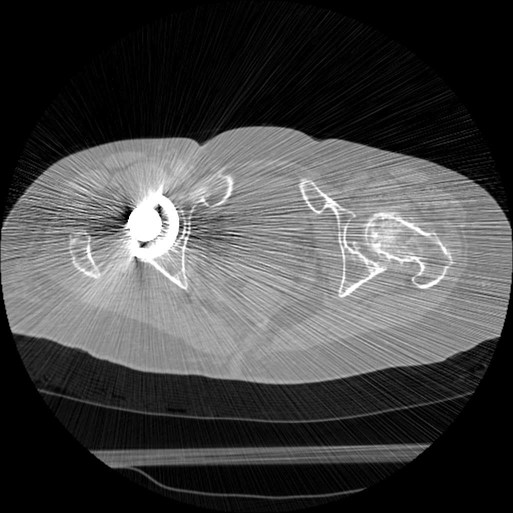Scalable Regularized Tomography
X-ray computerized tomography (CT) and other related imaging
modalities, such as positron emission tomography (PET), are
notorious for their excessive computational demands. While the
earliest algorithms in tomography, such as filtered
backprojection (FBP), are now trivial in two-dimensions and
scalable in three-dimensions due to their ``embarassingly
parallel'' nature, the more noise-resistant probabilistic
tomography methods are still prohibitive, especially in
three-dimensions and at high resolutions. In this project we are
studying a new class of algorithms in which probabilistic
tomography becomes ``embarassingly parallel'' as well.
To understand how, recall that tomographs are produced by
converting observed projections into an image. For example, in
X-ray CT, X-ray beams directed at a patient are
attenuated to varying degrees by the different materials within the body.
On the opposite side of the patient, the attenuated beams are detected as
with an array of measurements called a projection. Such
projections are produced at many different angles around the patient.
In reality these measurements are noisy, and the relative noise level even
depends on the amount of attenuation. In particular, projections through
dense materials such as bone and especially metal have lower
signal-to-noise ratio than projections through only flesh or water. Coping
with the large and spatially-varying fluctuations in the number of detected
photons often requires a probabilistic smoothing technique (also known as
regularization) to improve the image. The basic idea of regularization is
to infer a smooth image whose simulated projections approximate the
observed (but noisy) projections. The difficulty is that the standard
regularization specifies the two basic constraints in different
domains: (1) smoothness is an image property specified in the
image domain, while (2) closeness to the data is determined in the
projection domain. Enforcing these constraints computationally
requires a large sparse matrix-vector multiplication (projection or
backprojection) to convert between the two domains during processing. This
multiplication places heavy demands on system memory and memory bandwidth,
and requires significant network usage when parallelized (a global
summation).
The novelty in our formulation of regularized tomography is in the
analytical conversion of the smoothness constraint itself from the
image to the projection domain, before any computations begin. Thus the
most difficult part of the computation takes place entirely in the
projection domain. The standard (and expensive) practice of
numerically iterating between the image and projection domains is avoided.
Another benefit of the conversion of the smoothness
constraint to the projection domain is the decoupling of a large system of
regularization equations into many small systems of simpler regularization
equations. The difficult computation of regularized tomography
becomes ``embarassingly parallel'', so that latency tolerant and ideally
scalable parallel computations are possible, as our results
show in 2-d.
Demonstration
Before applying scalable decoupled regularization (click on
image to zoom):

This is a CT scan of a human hip with a metal hip implant shown
on the left. Observe the streak artifacts emanating from the
implant.
After applying scalable decoupled regularization (click on
image to zoom):

This is the result of our algorithm. Note that the streaking has been
reduced without a significant increase in blur.
Funding
This material is based upon work supported by the National
Science Foundation under Grant No. 0305719. Any opinions,
findings, and conclusions or recommendations expressed in this
material are those of the author(s) and do not necessarily
reflect the views of the National Science Foundation.

